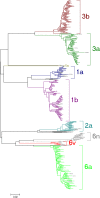Changing Epidemiology of Hepatitis C Virus Genotype among Patients with Human Immunodeficiency Virus/Hepatitis C Virus Co-Infection in China
- PMID: 27603929
- PMCID: PMC5014309
- DOI: 10.1371/journal.pone.0161844
Changing Epidemiology of Hepatitis C Virus Genotype among Patients with Human Immunodeficiency Virus/Hepatitis C Virus Co-Infection in China
Abstract
Background: Co-infection with hepatitis C virus (HCV) has become the most common cause of death in human immunodeficiency virus (HIV) infected patients on antiretroviral therapy. The distribution of HCV genotypes varies with geographical regions and time, and limited studies have focused on the HCV genotype in HIV/HCV co-infection.
Methods: The distribution of HCV genotypes was evaluated in 414 patients with HIV/HCV co-infection in three regions (South, Central and Northwest) of China from 2008 to 2010. The NS5B region of HCV was characterized using nested reverse transcription polymerase chain reaction. Nucleotide sequences obtained were subjected to phylogenetic analysis, and genotypes were assigned using published reference genotypes.
Results: Genotype 3 was the most prevalent HCV strain (36.2%), followed by genotype 6 (30.0%), genotype 1 (28.5%), genotype 2 (5.1%), and genotype 5 (0.2%). The distribution varied geographically. Genotype 6 (37.6%) was the predominant strain while genotype 1 (20.2%) was less common in the South compared to the Central and Northwest regions (all P < 0.001). The distribution also varied temporally. There was no significant difference in genotype distribution in Guangdong (a province in the South region), between patient cohorts from 2005-2008 and 2009-2010. However, outside Guangdong, genotypes 3 and 6a became significantly more prevalent (22.4% vs.42.2%, P< 0.001; 8.0% vs. 19.8%, P = 0.004), and genotype 1 less prevalent (54.4% vs.26.6%, P< 0.001) over time.
Conclusion: The most dramatic shift in genotypic distribution was the movement of HCV genotypes 3 and 6a outside of Guangdong in HIV/HCV co-infected patients. This movement appeared closely associated with transmission via injected drug use.
Conflict of interest statement
The authors have declared that no competing interests exist.
Figures


Similar articles
-
Epidemiological distribution and genotype characterization of hepatitis C virus and HIV co-infection in Wuhan, China, where the prevalence of HIV is low.J Med Virol. 2013 Oct;85(10):1712-23. doi: 10.1002/jmv.23650. Epub 2013 Jul 19. J Med Virol. 2013. PMID: 23868809
-
Differential prevalence and geographic distribution of hepatitis C virus genotypes in acute and chronic hepatitis C patients in Vietnam.PLoS One. 2019 Mar 13;14(3):e0212734. doi: 10.1371/journal.pone.0212734. eCollection 2019. PLoS One. 2019. PMID: 30865664 Free PMC article. Clinical Trial.
-
HCV genotype determination in monoinfected and HIV co-infected patients in Cuba.Trans R Soc Trop Med Hyg. 2012 Dec;106(12):711-7. doi: 10.1016/j.trstmh.2012.08.001. Epub 2012 Oct 15. Trans R Soc Trop Med Hyg. 2012. PMID: 23078671
-
Literature review of the distribution of hepatitis C virus genotypes across Europe.J Med Virol. 2016 Dec;88(12):2157-2169. doi: 10.1002/jmv.24573. Epub 2016 Jul 11. J Med Virol. 2016. PMID: 27171396 Review.
-
MicroRNAs, hepatitis C virus, and HCV/HIV-1 co-infection: new insights in pathogenesis and therapy.Viruses. 2012 Oct 26;4(11):2485-513. doi: 10.3390/v4112485. Viruses. 2012. PMID: 23202492 Free PMC article. Review.
Cited by
-
Transmission networks of hepatitis C virus among HIV/HCV-coinfected patients in Guangdong, China.Virol J. 2022 Jul 14;19(1):117. doi: 10.1186/s12985-022-01849-4. Virol J. 2022. PMID: 35836270 Free PMC article.
-
The distinct epidemic characteristics of HCV co-infection among HIV-1-infected population caused by drug injection and sexual transmission in Yunnan, China.Epidemiol Infect. 2019 Sep 2;147:e261. doi: 10.1017/S0950268819001365. Epidemiol Infect. 2019. PMID: 31475647 Free PMC article.
-
Growth history of hepatitis C virus among HIV/HCV co-infected patients in Guizhou Province.Front Genet. 2023 Jun 6;14:1171892. doi: 10.3389/fgene.2023.1171892. eCollection 2023. Front Genet. 2023. PMID: 37347053 Free PMC article.
References
-
- Lauer GM, Walker BD (2001) Hepatitis C virus infection. N Engl J Med 345: 41–52. - PubMed
MeSH terms
Substances
LinkOut - more resources
Full Text Sources
Other Literature Sources
Medical

